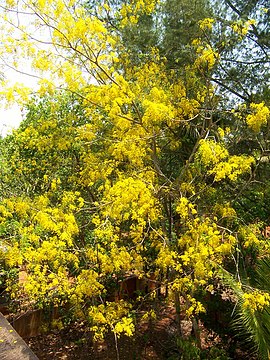
"Cassia fistula" redirects here. This taxon can also refer to other species; see below.
"Canafistula" redirects here. This can also refer to Albizia inundata (Maloxo).The Golden Shower Tree (see below for other names) is a flowering plant in the family Fabaceae, native to southern Asia, from southern Pakistan east through India to Myanmar and south to Sri Lanka. It is the national tree of Thailand.
The Golden Shower Tree is a medium-sized tree growing to 10–20 m (33–66 ft) tall with fast growth. The leaves are deciduous, 15–60 cm (6–24 in) long, pinnate with 3–8 pairs of leaflets, each leaflet 7–21 cm (3–8 inches) long and 4–9 cm (1.5–3.5 in) broad. The flowers are produced in pendulous racemes 20–40 cm (8–15 in) long, each flower 4–7 cm diameter with five yellow petals of equal size and shape. The fruit is a legume, 30–60 cm (12–23 in) long and 1.5–2.5 cm (0.5–1 in) broad, with a pungent odor and containing several seeds. The seeds are poisonous.
Cultivation and uses
Cassia fistula is widely grown as an ornamental plant in tropical and subtropical areas. It blooms in late spring. Flowering is profuse, with trees being covered with yellow flora, with almost no leaf being seen. It does not grow well in dry climates. Growth for this tree is best in full sun on well-drained soil; it is drought- and salt- tolerant, but will be damaged by even short spells of freezing weather. It can be subject to mildew, leaf spot and root diseases.
A flower in Chandigarh, India.
In Ayurvedic medicine, Golden Shower Tree is known as aragvadha ("disease killer"). Its fruitpulp is used as mild laxative, against fevers, arthritis, vatavyadhi (nervous system diseases), all kinds of rakta-pitta (bleeding, such as hematemesis or hemorrhages), as well as cardiac conditions and stomach problems such as acid reflux. The root is considered a very strong purgative, and self-medication or any use without medical supervision is strongly advised against in Ayurvedic texts.
Though its use in herbalism is attested to since millennia, there has been rather little research in modern times. While the purgative action is probably due to abundant 1,8-dihydroxyanthraquinone and derivates thereof, whether the reputed nervous system (anti-vatavyadhi) effects are real and if, what causes them, is not known. While many Fabaceae are a source of potent entheogens and other psychoactive compounds, e.g. tryptamines. Such plants are rarely found among the Caesalpinioideae.
The golden shower tree is the national flower of Thailand; its yellow leaves symbolize Thai royalty. A 2006-2007 flower festival, the Royal Flora Ratchaphruek, was named after the tree, which is most often called dok khuen or ratchaphruek in Thailand.[1]
The golden shower tree is the state flower of Kerala in India. The flowers are of ritual importance in the Vishu festival of Kerala state of India, and the tree was depicted on a 20 Indian rupees stamp. C. fistula is also featured on a 2003 joint Canadian-Thai design for a 48 cent stamp, part of a series featuring national emblems.
The tree has strong and very durable wood. There is please called "Ahala Kanuwa" in "Adems peek" "Sri Lanka" and its made by Cassia fistula (Ahala) heart wood.
There is also a rare case of it being used for anal autoeroticism.[2]
Names
Being so conspicuous and widely planted, this tree has a number of common names. In English, it is usually known as Golden Shower Tree or Golden Shower Cassia. Other, more ambiguous names include Indian laburnum, "golden shower" or "drumstick tree". It is known in Spanish-speaking countries as caña fistula.
Names from its native range and surrounding regions include:
Assamese: Xonaru
Bangla: sonalu, bandar lathi, Amaltas
Chinese: ā bó lè (阿勃勒: Taiwan), là cháng shù ("sausage tree", 腊肠树)
Gujarati : Garmalo
Hindi: bendra lathi (or bandarlauri), dhanbaher (or dhanbohar), girimaloah
Hindi and Urdu: amaltās (अमलतास)
Japanese: nanban saikachi (ナンバン サイカチ, Kanji: 南蛮皀莢)
Khmer: 'reachapreuk' (rajavriksha)
Lao: khoun
Marathi: bahava (बहावा)
Malayalam: kanikkonna (or kani konna കണിക്കൊന്ന: Kerala), Vishu konna(വിഷുക്കൊന്ന)
Meitei (Manipuri): chahui
Nepali: amaltash, rajbriksya
Sanskrit: aragvadha, chaturangula, kritamala, suvarnaka
Sinhalese: aehaela-gaha (or ahalla-gass), ekela
Tamil: konrai (கொன்றை)
Telugu:Raela
Thai: rachapruek (ราชพฤกษ์), khun (คูน), dok khuen (ดอกแคน
